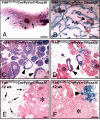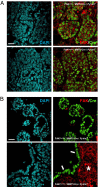Mammary epithelial-specific disruption of the focal adhesion kinase blocks mammary tumor progression
- PMID: 18056629
- PMCID: PMC2154426
- DOI: 10.1073/pnas.0710091104
Mammary epithelial-specific disruption of the focal adhesion kinase blocks mammary tumor progression
Abstract
Elevated expression and activation of the focal adhesion kinase (FAK) occurs in a large proportion of human breast cancers. Although several studies have implicated FAK as an important signaling molecule in cell culture systems, evidence supporting a role for FAK in mammary tumor progression is lacking. To directly assess the role of FAK in this process, we have used the Cre/loxP recombination system to disrupt FAK function in the mammary epithelium of a transgenic model of breast cancer. Using this approach, we demonstrate that FAK expression is required for the transition of premalignant hyperplasias to carcinomas and their subsequent metastases. This dramatic block in tumor progression was further correlated with impaired mammary epithelial proliferation. These observations provide direct evidence that FAK plays a critical role in mammary tumor progression.
Conflict of interest statement
The authors declare no conflict of interest.
Figures





References
-
- Guo W, Giancotti FG. Nat Rev Mol Cell Biol. 2004;5:816–826. - PubMed
-
- Hannigan G, Troussard AA, Dedhar S. Nat Rev Cancer. 2005;5:51–63. - PubMed
-
- Playford MP, Schaller MD. Oncogene. 2004;23:7928–7946. - PubMed
-
- Mitra SK, Schlaepfer DD. Curr Opin Cell Biol. 2006;18:516–523. - PubMed
-
- White DE, Kurpios NA, Zuo D, Hassell JA, Blaess S, Mueller U, Muller WJ. Cancer Cell. 2004;6:159–170. - PubMed
Publication types
MeSH terms
Substances
LinkOut - more resources
Full Text Sources
Other Literature Sources
Molecular Biology Databases
Miscellaneous

